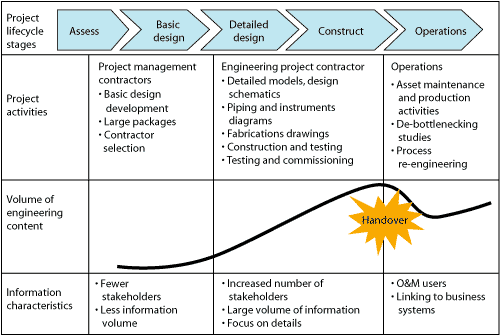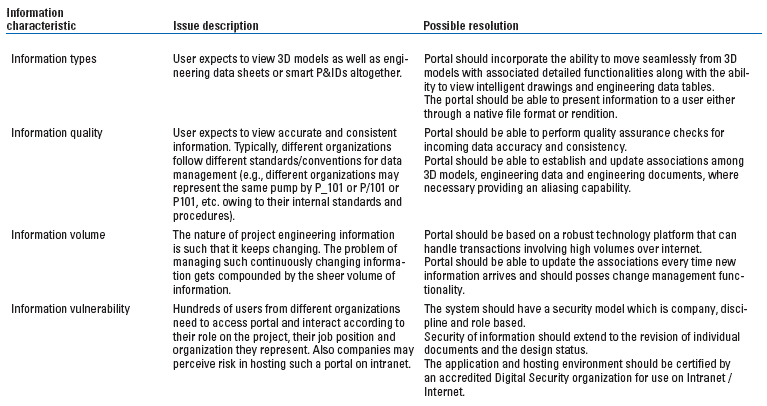INFORMATION TECHNOLOGY
Engineering portals add significant value to E&P project delivery capabilities
A portal approach enables information sharing among globally spread E&P project stakeholders.
Kailash Samdani, Infosys Technologies Limited and Andy Till, BP Exploration Limited.
INTRODUCTION
An E&P project is a complex engineering effort involving hundreds of engineers from different organizations, working together to design, construct and commission an asset before handing it over to the owner/operator. Efficient project management requires that engineering information is available to all key stakeholders in a way that enables them to work as one integrated organization.
There are numerous challenges in sharing and viewing engineering information from various sources, spread globally. An engineering information portal provides a single window to view the information in a secure manner. It enables easy collaboration between stakeholders and supports productivity gains.
BACKGROUND
Building a new E&P facility can cost $1-5 billion, taking three to five years to complete. As facility complexity increases, the tradition of nominating a single lead EPCM (Engineering Procurement and Construction Management) contractor is being replaced by a consortium of EPC contractors. As a result, the owner/operator is taking on more responsibility for the management of interfaces between stakeholders. Oil and gas companies are developing and implementing new information management strategies to support their evolving role and improve their project execution capabilities.
Recent advances in technology are allowing organizations to take new management approaches of project information. First, the link between authoring applications and publishing applications has been broken and, as a result, documents and 3D models can be viewed independent of the tool used to create them. Second, the advancements in portal technology enable all stakeholders to view project information on the internet.
Organizations are adopting portal technology to publish project engineering information. Being able to share and review project engineering information leads to significant benefits. Since published information is available instantly-independent of stakeholder authoring system constraints or geographical location-information cycle times are reduced. A portal system uses a single integrated window to access all types of engineering content, such as 3D models, intelligent drawings, data sheets and engineering databases. Also, operators are better prepared to run the asset due to early exposure to engineering information that allows them space and time to develop and validate supporting procedures and processes.
TYPICAL PROJECT LIFECYCLE
Figure 1 provides an overview of a typical project lifecycle. The project’s assess phase is about determining the hydrocarbon potential and making a business case for field development. Once the business case is in place, a basic design development and selection of Original Equipment Manufacturers (OEM), vendors and contractors is carried out in basic design. Subsequently, detailed plans and drawings are developed in the detailed design phase. Fabrication, construction and commissioning activities for various systems and equipments are carried out in the construct phase, which ends in handing over the project to operations.
As shown in Fig. 1, engineering information volume increases as the project progresses from one phase to another. During the detailed design and construct phases, the volume of engineering information shared and viewed reaches peak. Engineering information, such as hundreds of 3D models, hundreds of thousands of documents and millions of engineering data attributes, are shared and viewed in this virtual explosion of engineering information.
 |
Fig. 1. Project lifecycle and information explosion.
|
|
Hundreds of engineers and designers belonging to various project stakeholders such as owner, EPCM contractor, fabricators, vendors, etc, generate, share, review and publish engineering information. Different systems and processes exist across these organizations to validate and share the information. Traditionally, a project owner has little visibility of the information being exchanged among the external project stakeholders on their behalf. From a project perspective, this leads to multiple sets of truths across organizations which, if not managed appropriately, can result in contradictions and potential delays affecting the project schedule.
The logical conclusion of E&P projects, as shown in Fig. 1, is the handover of the facility to the operations team. It is crucial for operations to have a complete set of cleansed and validated engineering information so that they can efficiently run and maintain the asset. Traditionally, the operations teams received information in bulk toward the end of the construct phase at the time of handover. It is humanly impossible to review and validate all shared information during the handover process.
Several problems exist due to lack of a proper environment for sharing information. Little visibility leads to lack of control on engineering activities and progress. Project reviews can be delayed due to inconsistent information across multiple stakeholders. Productivity losses can occur as a result of the overheads in searching and retrieving required project documentation. Operators are ill-prepared to run and maintain the asset because of the bulk of information that is shared at the time of hand-over. Technology advances enable project owners to adopt a portal approach, which addresses a number of such issues.
A PORTAL APPROACH
A portal approach provides a single window to all project engineering content such as 3D models, intelligent documents and datasheets. It displays two types of information sets: published information (e.g., a document with a specific revision number which will never change but could be superseded) and snapshot information (e.g., a copy of a 3D model at a specific time). Through a cleansing and validation process, these information sets can be aggregated together into an engineering portal as shown in Fig. 2.
 |
Fig. 2. Project engineering information portal. Engineering Data Warehouse (EDW), Engineering Document Management (EDM) and Engineering Procurement Contractor (EPC).
|
|
When the portal is accessed, users are provided with requisite information of all types from all stakeholders. Stakeholder organizations need to have systems (e.g., engineering data warehouse, engineering document management systems, modeling systems) and processes (such as data cleansing and validation processes) to publish a variety of engineering information to a portal environment.
Project organizations desire to improve the availability and visibility of engineering information throughout the project lifecycle to optimize concurrent engineering, minimize information cycle time and eliminate rework due to poor information. Requirements from a portal solution can be categorized into three broad areas.
Functional requirements. A portal solution should provide a single window to different project engineering content, such as models, engineering databases and intelligent, as well as dumb, drawings and documents. It should enable easy navigation through various information sets, so that users can move seamlessly across different content types. It should be independent of source systems and be able to interface with proprietary file formats from multiple suppliers. It should support quality assurance checks before the information is published on the portal. It should also manage updated content from stakeholders. It should enable role based workflow capabilities coupled with an information security model and also support collaboration among all users spread geographically.
User requirements. A portal solution should provide viewing capabilities to analyze information contained within 3D models and intelligent drawings e.g., zoom in/out, collision detection, mark-up, etc. It should provide easy, yet advanced, search mechanisms to get to desired information within a minimum number of mouse-clicks.
Technical requirements. A portal solution should allow information to be accessed over the web in a secure manner, as well as in remote offshore areas and high latency-low bandwidth areas. It should be able to interface with source systems on the internet as well as intranet.
ISSUES AND POSSIBLE RESOLUTIONS
Good information specifications are needed for all projects. A portal approach quickly highlights inconsistencies in the project information. The true cost of implementing a portal approach is marginal when compared to the real cost of getting the relevant project information. If a project aspires to use a portal approach, it must have a clearly defined and published approach to information management. The requirement of sharing accurate, consistent and complete information must be contractually binding on all information suppliers. It is preferable to have information validated and cleansed before it is published.
Projects adopting a portal approach to access project information can face a number of issues because of the nature of information being handled. The project information can be characterized as:
- Information types: Multiple native file formats exist according to the authoring system (3D models, intelligent drawings, engineering data, etc).
- Information quality: Completeness and consistency of information coming from different organizations or systems varies.
- Information volume: Hundreds of 3D models, hundreds of thousands of documents, and millions of engineering data attributes are available to view.
- Information vulnerability: Information accessed by large numbers of users from different organizations gives rise to security concerns.
Each information characteristic gives rise to a set of unique issues. These issues and resolution approaches are covered in Table 1.
TABLE 1. Issues with portal solution and possible resolutions
Click table to enlarge. |
 |
|
BENEFITS OF PORTAL APPROACH
A portal approach provides benefits in many areas. Easy access to current and consistent information is one of the key parameters to successful execution of large projects. A portal approach provides a single window to the published information, thus improving availability of requisite drawings and documents leading to better preparedness for project reviews in less time. It enables quick access to current information, moving seamlessly between otherwise unrelated data sets. The ability to share and view information with multiple stakeholders across geographies improves team collaboration, which results in more informed and quicker decisions due to increased visibility. Developing and updating hook-up and commissioning workpacks is easier and saves time. Portals enable simplified and progressive handover of information to operations, which enables them to contribute to reviews of operation and maintenance apart from developing work procedures and training manuals in advance. Portals enable a population of data into enterprise systems, such as maintenance management, document management and engineering data warehouses. Also, since the bulk of engineering or vendor data is common across projects, a portal system substantially reduces the cost of information for future projects.
CONCLUSION
As the size of E&P projects continue to grow, the way in which stakeholders interact needs to evolve. Larger and more complex projects need to develop more appropriate ways of project execution. Technology advances are being increasingly used to make projects more efficient. The web-based portal approach enables organizations to control and share project information among global stakeholders and reduce information cycle time, thus improving the speed of execution, leading to a successful delivery of the project into operation. 
|
THE AUTHORS
|
|
Kailash Samdani works with Domain Competency Group of Infosys Technologies Ltd. Kailash has 15 years of experience in pre-sales, consulting and business development of IT enabled advanced solutions to hydrocarbon, chemicals and metal industries. He has a BS degree in chemical engineering from Birla Institute of Technology & Science, Pilani, India. He can be reached at Kailash_Samdani@infosys.com.
|
|
|
Andy Till worked for BP Exploration Ltd for 18 years in a number of roles and is currently an IT consultant for Major Projects. Andy spent his first eight years as an engineer designing, constructing, installing and commissioning both onshore and offshore facilities before moving to IT, where he continues to support both engineering and projects.
|
|
|







